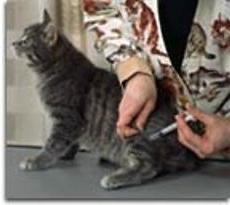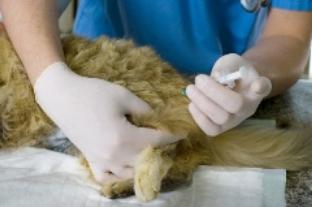Owners of animals periodically face the question of how to give injections to their pets? In case of illness of your pet, you must immediately seek help from a veterinarian, sometimes a few hours can be crucial for the life of the animal. However, there are emergency cases, such as food poisoning or allergic shock. Then, how to give injections, you have to learn the breeder. In this situation, you can help out the call to your veterinarian who will advise which drug and in what dosage you need to enter. It is important to know that various medications are administered to cats and dogs either in the thigh or under the skin at the withers. As a rule, antibiotics and painkillers are injected intramuscularly, and antiparasitic drugs and vaccines are subcutaneous. Before giving injections, check with a specialist where to prick in your case! It should be added that not all medicines for humans are suitable for animals; special medicines can be purchased at veterinary pharmacies or directly from your doctor.

Now let’s take a closer look at how to give a cat an injection correctly. If the animal is very weak and does not respond to irritants, simply draw the drug into the syringe, release excess air and give an injection. For cats and small dogs, an insulin syringe is enough , its injection is almost invisible. The only drawback of insulin syringes is that the needle can bend if the cat gets scared and twitches during the injection. If your cat is familiar with the needle firsthand and becomes nervous, you may need help from a second person. Stroking and soft, but confident tone will help the animal relax, however, keep a towel ready in case the cat starts to fight off and put its claws in motion. Be sure to fix the paws without hurting the pet and scaring it. Bring the syringe prepared in advance to the back so as not to fix attention on it. With a subcutaneous injection, collect the skin at the withers and slightly pull it up, make a puncture quickly, in one motion. Be careful not to pierce the fold through, make sure that the needle is under the skin, and then enter the medicine. How to give injections intramuscularly? In the soft tissue of the thigh, closer to the tail. Prepare a syringe, probe the paw and prick vertically with a confident, but not sharp movement. In no case can you get into the bone, this can cause a number of complications. After the injection, offer the animal a treat so that the procedure does not cause him negative emotions.

How to inject a dog, because it can be larger and more aggressive than a cat? Here the situation is both simpler and more complicated at the same time. Large dogs will need a syringe with a longer needle and an injection, respectively, will be noticeable. However, in animals the pain threshold is lower than in humans, and a correctly made injection will not give them painful sensations. If your dog is annoyed, put a muzzle on her and calm her down. Sometimes it’s enough to give a command, and a raised dog will endure the procedure without discontent. In special cases, you have to distract the dog with food or a toy, and at the same time put an injection. Subcutaneous injections are done at the withers, given that the skin of the dogs is thicker than feline. Intramuscular injections are more noticeable, so hold the dog so that it does not rush. If the animal lies, the muscles are relaxed and the needle enters unnoticed. After the procedure, pet your pet, treat and demonstrate your love.

Another important question that you may have is: do I need to treat the injection site with an antiseptic? Many veterinarians do not do this, but it will not be amiss to hedge, especially if you give an injection to an animal that spends a lot of time on the street. Any liquid containing alcohol is suitable for processing; we treat the skin before and after the injection. Now you know how to give injections to your pets and take care of their health.